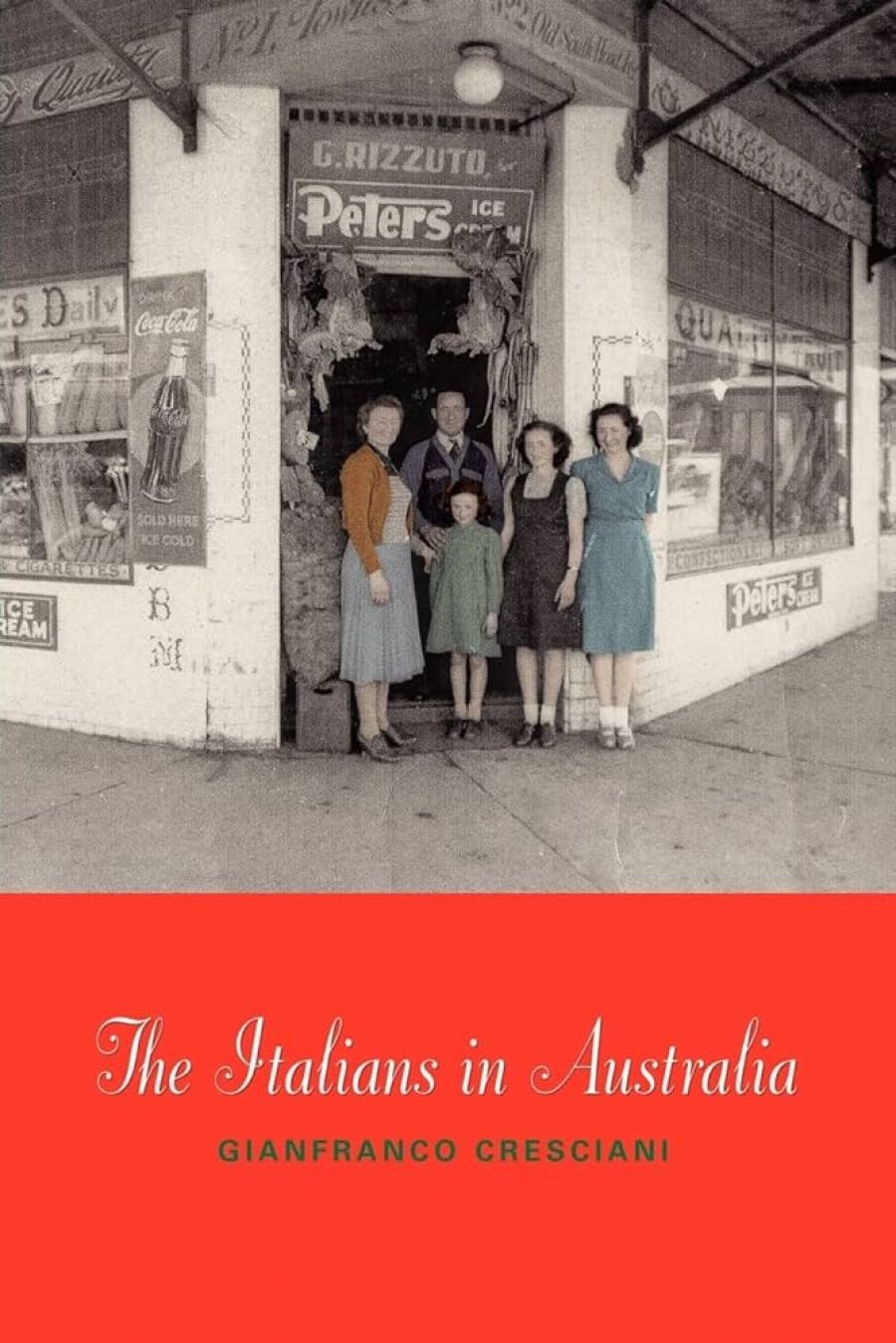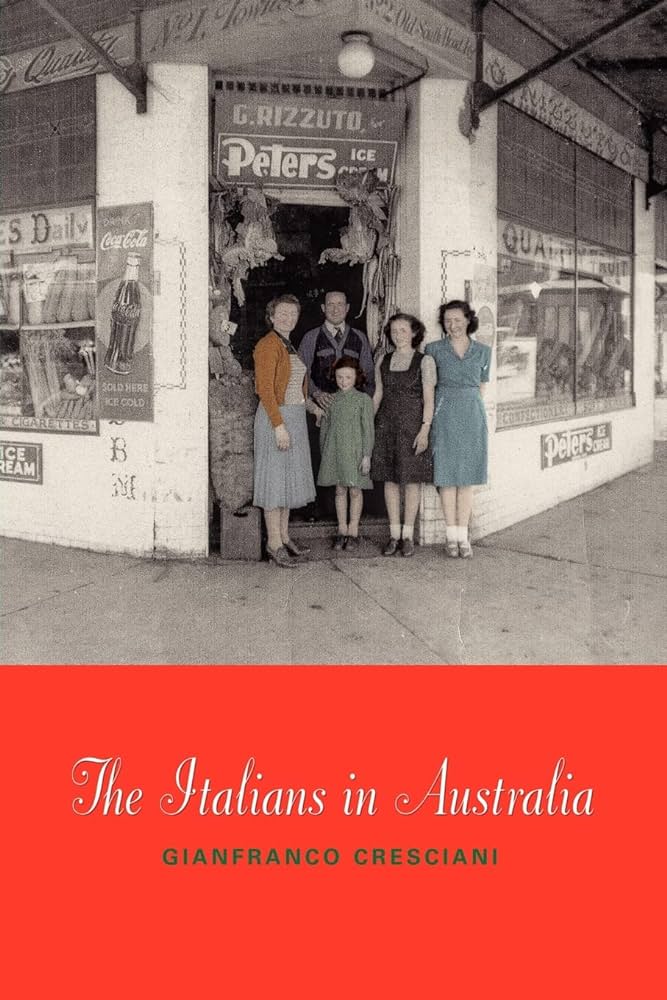
- Free Article: No
- Contents Category: Non-fiction
- Review Article: Yes
- Article Title: Transnational Times
- Online Only: No
- Custom Highlight Text:
Cresciani’s very readable revised edition of The Italians is particularly informative on the early history of Italo-Australia. First published in 1985 with ABC Enterprises, based on the excellent television series of the same name, this new edition promises to provide ‘the definitive account’ of Italian life in Australia ‘into the twenty-first century’. Cresciani’s treatment of certain aspects of Italian migration to Australia is worthy of such a bold claim. He is especially good at weaving together the histories of both countries to provide an instructive account of how the vicissitudes of one indelibly affected the other. His treatment of contemporary immigrant life, however, is rather dated.
- Book 1 Title: The Italians in Australia
- Book 1 Biblio: CUP, $37.95 pb, 208 pp
- Book 1 Cover Small (400 x 600):

- Book 1 Cover (800 x 1200):

The book can be divided into three sections. Early chapters explore how missionary work, geographic exploration and the vain desire to establish colonial ‘interests’ in the area characterised the endeavours of ‘official Italy’ in nineteenth-century Italo-Australia, while prospecting for gold and adventure were the motives of the relatively few ordinary Italian migrants at that time. Middle chapters cover the first half of the twentieth century, with detailed insights into its wars and their impact on migrant life. These years brought the first Italian immigrants, in search of a living and a better income, although, like the vast majority of Italian migrants, they ultimately intended (initially, at least) to establish themselves back in the homeland. This fact is largely overlooked by Cresciani, who is inclined to see Italian migrants as individuals intent on settlement in the new land, rather than as members of transnational households enacting the tried and tested economic strategy of return-migration for the benefit of their extended families. The phenomenon of repatriation (33.5% between 1960 and 1969), and the government inquiries that aimed to stem it, are largely absent from this text. Final chapters encompass the period of mass Italian immigration in the 1950s and 1960s to the present, revealing how postwar poverty in Italy, Australia’s need for labour and defence (against the perceived threat of the ‘yellow peril’) and the closing of immigration channels to the US resulted in the Assisted Migration Agreement of 1951, which, for the first time in White Australia’s history, allowed the entry of significant numbers of ‘less-desirable’ immigrants from Italy.
Cresciani is at his best when describing the history of the first generation, people like him who migrated from the miseria of Italy’s poorest regions to make a better future for themselves and their children in Australia. His expertise on war, fascism and internment is evident. Careful archival and oral-history research supports his heartfelt account of the difficulties and hardship of migration. The book is a timely reminder of the extent of the racism, xenophobia and abuse experienced by Italian migrants, attitudes so easily forgotten in multicultural Australia. Cresciani argues that the impact of the history of prejudice has left most first-generation Italian migrants poor and alienated. Cresciani’s image of today’s Italians challenges their reputation as the success story of multicultural Australia.
The Italian aged, like other Australians from non-English-speaking backgrounds, have special needs that render them ‘at risk’. However, Cresciani’s reliance on income and education statistics provides a limited gauge of their wealth. What of their much higher than average home-ownership levels, and what of their children’s increasing move into the professions? Cresciani’s conclusion that Italians in Australia ‘have been bypassed by history’ and that they are ‘largely unaware of the momentous progress achieved by the Italian people in the last fifty years’ is too narrow. His treatment of more recent times tends to stereotypes of culture loss and decay, and is not backed by research. He sounds the death knell for the future of Italo-Australia, arguing that Italian culture will die with the rapidly ageing first generation. This pessimism might have been tempered by an examination of studies on the second and subsequent generations, not to mention the phenomenon of ‘wog pride’ and the numerous works of theatre, fiction and biography by second-generation authors. Cresciani offers no glimpse of the not exactly provocative view that a unique Italian-Australian culture has developed with its own specific blend of cultural mores, continuously changing and adapting to circumstances as all cultures do.
This failure to update his research explains why the book is devoid of any reference to more recent transnational approaches to migration studies, and produces some contradictory findings. Cresciani writes about the migrants’ nostalgia for Italy, yet also argues that the migrants forgot their homeland or that they were uninterested in it. His penchant for the ‘frozen in time thesis’, where migrants get stuck in the traditions of their past, leads to a limited and rather naïve reading of contemporary experience. His analysis does not account for the often frequent return visits (including the considerable regional funding poured into riconoscimento and tourism tours), the increasing traffic in e-mail and other forms of communication between the two countries, and the availability of Italian news and current affairs. It is not so much a lack of contact with present-day Italy as local multicultural politics, with their emphasis on defining people according to ethnic identity, that reinforce the boundaries of a traditional italianità. The absence of any sustained discussion of later generations or of notions of transnationalism means that the book falls short of being a full representation of Italo-Australia in the present century, leaving a gap in an otherwise finely drawn picture. Overall, however, the book’s strength is the lesson it provides on the brutality of assimilationist migration policies and on the continuing need in this country for a deeper understanding of the moral and political challenges of a genuine multiculturalism.


Comments powered by CComment